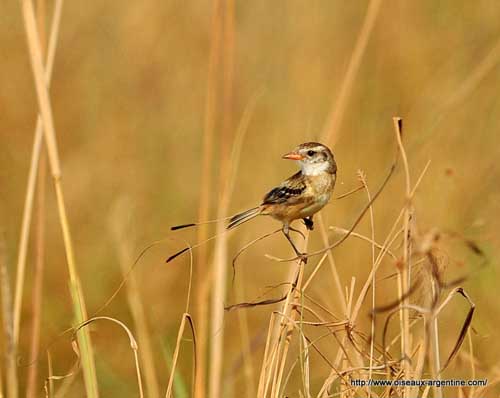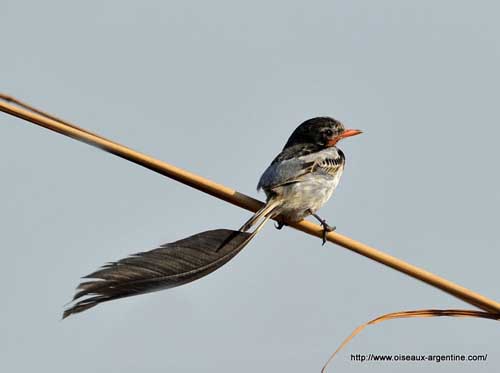
Fr: Moucherolle à queue large
All : Rotkehl-Schleppentyrann
Esp: Yetapá Acollarado
Ital: Tiranno codastrana
Nd: Wimpelstaart-tiran
Sd: Vimpeltyrann
Port: Tesoura-do-campo
Photographers:
Philippe et Aline Wolfer
GALERIE
Text by Nicole Bouglouan
Sources :
HANDBOOK OF THE BIRDS OF THE WORLD Vol 9 - by Josep del Hoyo - Andrew Elliot - David Christie - Lynx Edicions - ISBN: 8487334695
BirdLife International (BirdLife International)
Wikipedia, the free encyclopaedia
XENO-CANTO – Sharing Birds sounds from around the world
Strange-tailed Tyrant
Alectrurus risora
Passeriforme Order – Tyrannidae family
BIOMETRICS:
Length Female: 20 cm
Length Male: 30 cm with the tail in breeding plumage
DESCRIPTION:
This monotypic species might be similar to some Viduidae regarding the bird perched at top of tall grass with the wind swaying the long tail. The silhouette is the same due to this physical resemblance between them. Both species are included in the Order Passeriformes but in separate families.
The adult male in breeding plumage has mostly black upperparts with brown-edged feathers in fresh plumage. The rump is grey. The scapulars are whitish. The wing-coverts are white-tipped and the flight feathers show white edges.
The tail is elongated. The outer tail feathers are twisted and highly modified. They are reduced to the shaft at base, but then, the inner web becomes very broad. These blackish feathers hold perpendicular to and below the rest of the tail.
On the underparts, chin and throat are bare and pinkish-red to pinkish-orange. We can see a broad, black breast band, and the rest of the underparts are white.
The head is black with whitish forehead, forecrown and short eyebrow.
The bill is pinkish-orange. The eyes are dark brown. Legs and feet are grey. We can see a long hind-claw.

In non-breeding plumage, the male usually has narrower and shorter tail feathers, and chin and throat show white feathers instead of bare red skin.
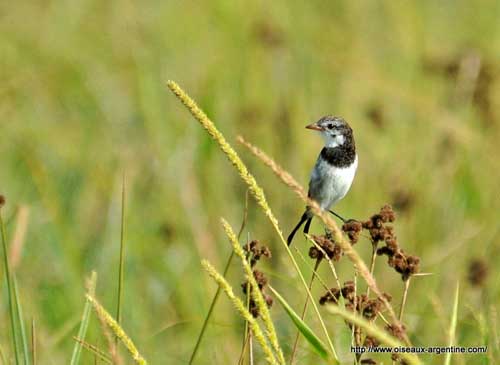
The female has mottled brown upperparts and head, white throat and buffy-white underparts with brown breast band. The tail is black with elongated and reduced outer rectrices ending in small racquets.
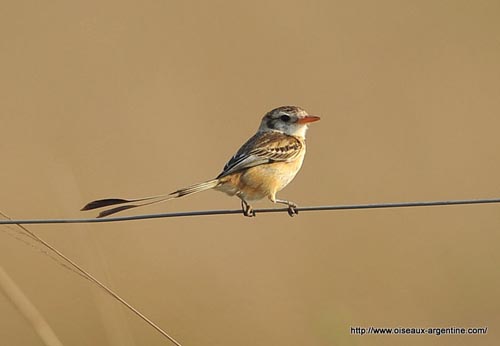
VOICE: SOUNDS BY XENO-CANTO
The female’s call is a soft, weak whistle “thee-uu, schee-uu” repeated several times, ending in descending notes.
The male produces some noises when performing wing flapping during the displays. It gives short “tsit-tsit-tsit-tsit…” during the flight displays.
HABITAT:
The Strange-tailed Tyrant frequents wet areas such as marshes and damp grasslands, but also savannahs and shrubby areas. It is usually seen below 500 metres of elevation.
RANGE:
The Strange-tailed Tyrant is found in S Brazil, N Argentina, E Paraguay and Uruguay, but the most important populations are now in S Paraguay and NE Argentina.
This species is resident in its range, but the southernmost populations may be partial migrant.
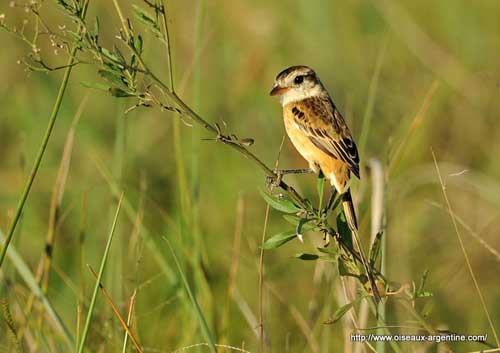
BEHAVIOUR:
The Strange-tailed Tyrant feeds mainly on insects and some other invertebrates. It catches them by sallies from perches. The bird is usually seen perched at top of tall grass stems, or prominent perch on shrub or fence. It sallies into the air to catch flying insects, but also to the ground for preys hidden in the grass. It also follows the army ants.
This is a fairly gregarious species, forming loose flocks of about 20-30 birds outside the breeding season.
This species breeds during the austral spring. They have complex mating system. Breeding groups with both monogamous and polygamous males can be maintained for several years.
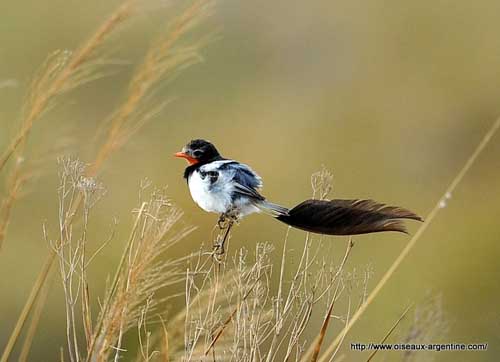
During the breeding season, the male loses the white feathers of the throat which becomes bare and red-orange. It defends its territory in grassland and grassy marsh habitats. It performs striking flight displays over the females perched on tall grasses and bushes.
These displays enhance the long tail feathers which dance while the bird is flying. The red throat is probably displayed too.
Some territories may contain several females and the males display at lek where females visit them. Interactions between males are accompanied by songs. These leks are often located in the forest, and crossed by usual travel routes used by females.
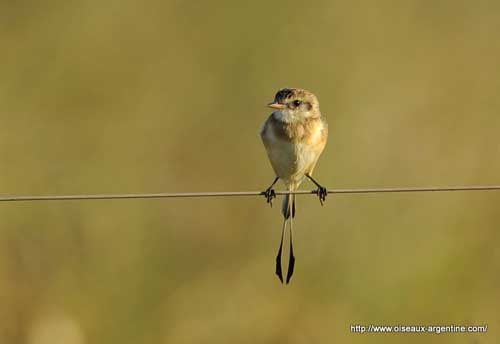
FLIGHT:
The Strange-tailed Tyrant performs spectacular flight displays. However, its flight is slow and weak, due to the short wings and the long tail. The long rectrices whip up and down, but they also may be carried straight down beneath the other tail feathers.
The flight may become graceful with the movements of the long feathers while the bird is flying.
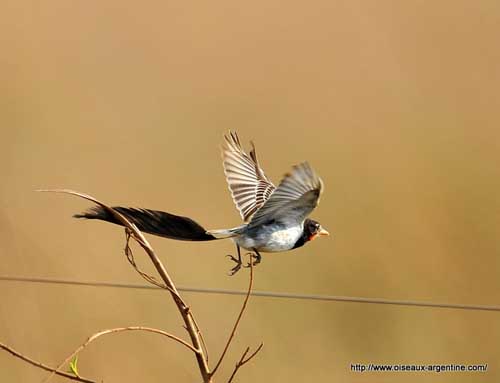
REPRODUCTION:
The nesting behaviour of the Strange-tailed Tyrant is poorly known. The eggs are laid between September and December. The nest is an open cup made with grass and lined with feathers. It is situated on or near the ground, hidden among the tall grasses. The female lays three eggs.
DIET:
The Strange-tailed Tyrant feeds mainly on insects and other invertebrates caught by sallies from exposed perches. Preys are taken in flight or on the ground.
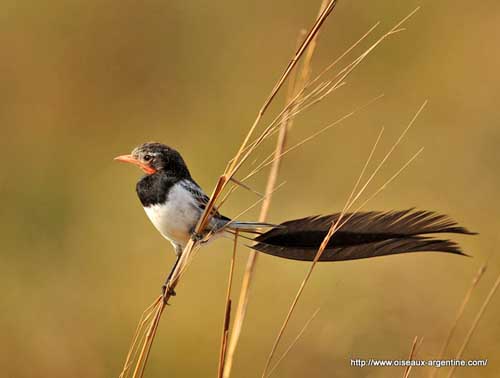
PROTECTION / THREATS / STATUS:
The Strange-tailed Tyrant is a Vulnerable species, becoming rare to locally uncommon.
This species is highly threatened by degradation and changes of its habitat for expansion of agriculture and farmland. The grasslands where these birds are nesting are disappearing, giving increasingly fragmented habitat and range. These grasslands are burned, drained and modified for pasture, plantations and agriculture. This species needs tall grasses to live in, and is intolerant of regular burning.
Conservation measures are underway and new ones are still proposed in order to protect this beautiful bird.
